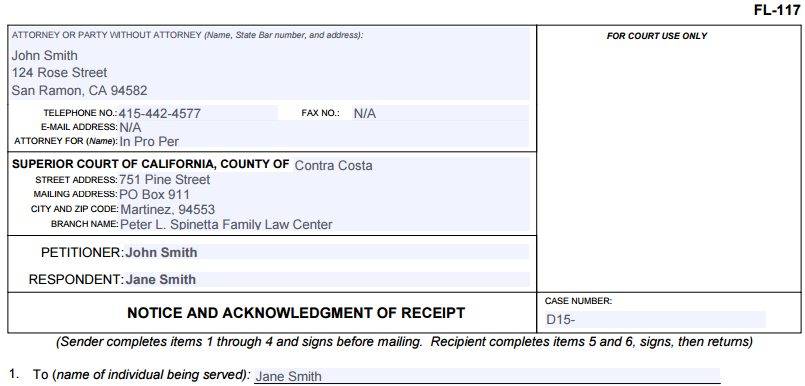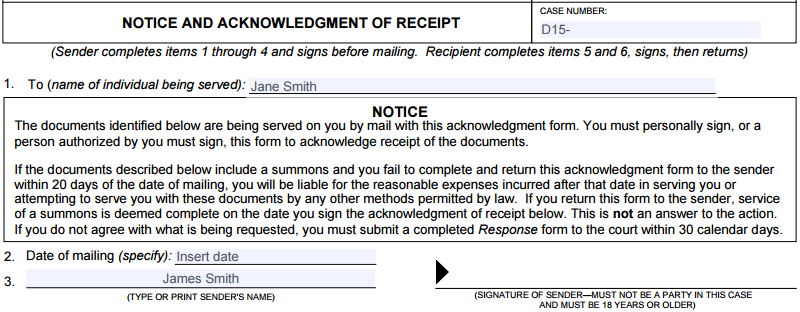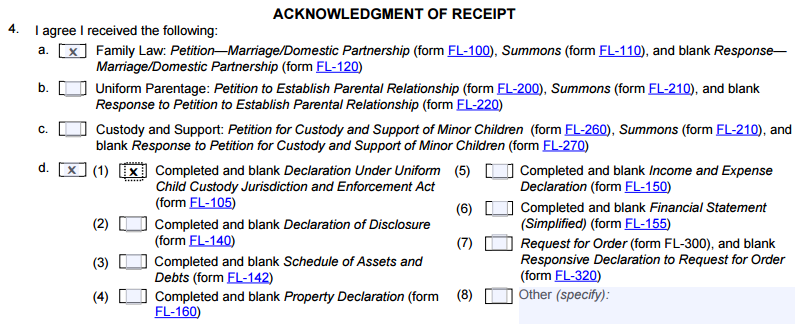Petitioner without Children
California Divorce Form FL-117
As petitioner, Form FL-117 applies if you serve the initial divorce papers on your spouse via mail.
The next article in our series covers California Family Law Form FL-117, which is the Notice and Acknowledgement of Receipt. This form is required when you’re opting to serve the Petition (FL-100), Summons (FL-110), and if you have minor children, the UCCJEA (FL-105), by mail to your spouse.
Serving by mail is a good idea when the two of you get along, things are amicable, and there’s a level of trust that still exists. It’s suitable to avoid potential embarrassment to your spouse as well. Trust is required because your spouse will need to fill out this form and return it to you. If you don’t feel they’ll be responsible enough to perform this task, you might opt for personal service instead. It’s going to come down to convenience and what works best in your situation. If you are amicable with your spouse, have a brief discussion to figure out the best option for the two of you.
You’ve decided on service by mail, so you’re going to complete this form and mail it along with a blank copy to your spouse with the other forms mentioned above.
Personal and Court Information

FL-117: Personal and Court Information
Continuing on with our sample family, the Smiths, input your personal information. Our petitioner John is in Contra Costa County and his address is 124 Rose Street in San Ramon, California, 94582. His phone number is (415) 442-4577. Remember, the fax number and email address are optional in Contra Costa County, and we’re going to input, “In Pro Per” in the, “Attorney For” field. The courthouse in Contra Costa is located 751 Pine Street. The mailing address is PO Box 911, and the city and zip code, Martinez, 94553. By the time you arrive at this form, you should know the branch name as Peter L. Spinetta Family Law Center. The petitioner asking for (or filing for) the divorce is John Smith, and the respondent would be his spouse, Jane.
Case Number:
If you’re filling out this form, you’ve already served (or are in the process of serving) the respondent, and you’ve already filed your petition (FL-100) and your summons (FL-110) with the court. You should also have a case number, and from now on you need to include your case number on every document. In Contra Costa County, it starts with “D.” If the filing year is 2016, and then it’s going to be, “D16-” and your assigned 5 digit number.
1: Name of Individual Being Served

FL-117: 1 – Name of Individual Being Served
In the sample case, it is going to be the respondent Jane Smith. Immediately above that line in parentheses, it mentions “Sender completes..,” meaning you, the petitioner, or in this case John, will be completing items 1 through 4 before mailing.
2: Date of Mailing & 3: Sender’s Name

FL-117: 2 – Date of Mailing & Sender’s Name
Recall from form FL-115 that the individual that performs the service is someone over 18 and not a party in the case. Our sample petitioner, John, had his dad James serve for him. His name will go in this field, and the date is the date he mailed out the documents. James will then sign on the line to the right.
4: Acknowledgment of Receipt

FL-117: 4 – Acknowledgment of Receipt
In our sample case, we need to remember what is to be served (in the case of this form,service by mail) to respondent Jane, and what you will likely serve on your spouse:
- FL-100
- FL-110
- FL-120 (blank)
5, 6: Recipient’s Section

FL-117: 05, 06 – Recipient’s Section
Respondent Jane will need to sign and date, then mail back to you. We touched on the responsibility factor when it comes to your spouse, so you have to trust them to follow through. The respondent is to sign and send it back within twenty days of the date that it was mailed.
This form is not a stand-alone form, but goes along with the Proof of Service of Summons (FL-115). If you are serving by mail and Notice and Acknowledgement of Receipt, this form, once completed and received from your spouse, is part 2 of FL-115. You’ll take these to the court for filing.
If you spouse doesn’t follow through, you’re going to have to rely on personal service. This takes you back to making the right decision as far as method of service based on your personal situation. For any other questions, please contact us at 925-215-1388, or you can reach me via email.
Petitioner without Children Path
Need Help?
Not a Petitioner without Children?
Choose the right forms based on your circumstances.
DIY Divorce Video Series
You're on the Petitioner without Children specialized track. Change your course or learn more about all of the court forms involved in a California divorce at our DIY Divorce Center. (scroll to dismiss this notice)
